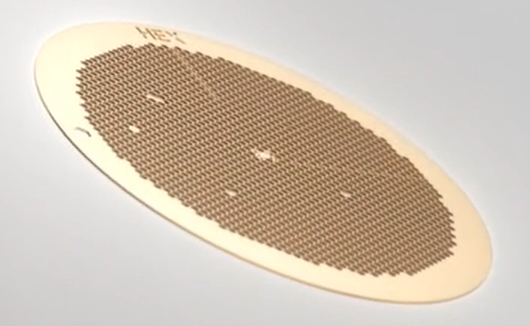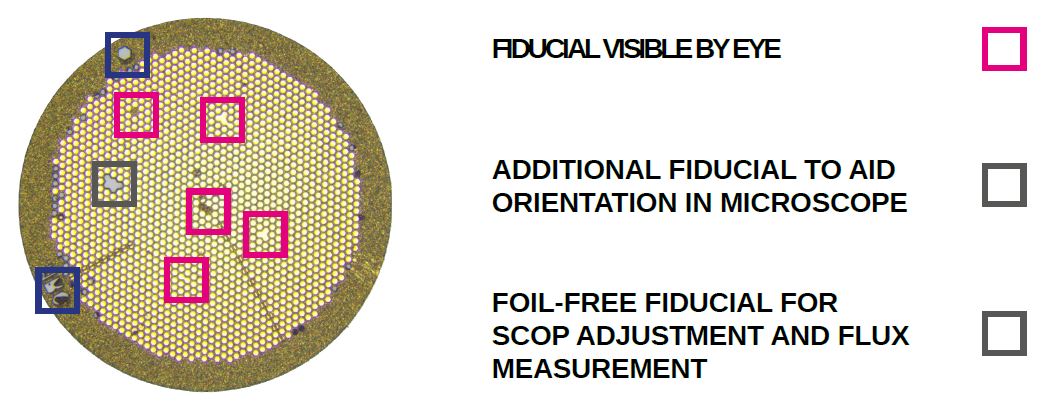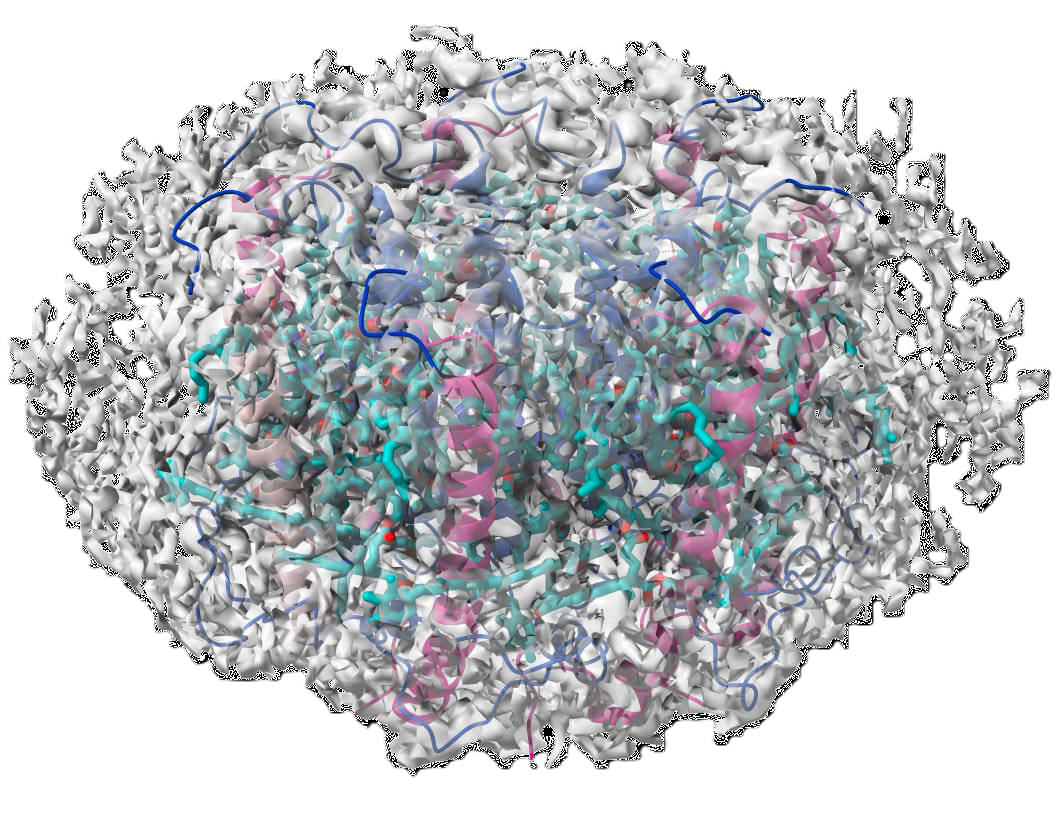



HexAuFoil® Ultra-small Hole Gold Grids
HexAuFoil® ultra-small hole gold supports reduce particle movement to sub-Ångstrom levels: the grids small hole size provides extra support to the thin ice layer that supports biological specimens and thus reduces or eliminates ice buckling caused by the stress of cryo-cooling.
The resultant improvement in particle localisation enables maps to be extrapolated to zero electron loss, before radiation damage. At the same time as reducing particle movement, consideration has been given to increasing automated cryoEM throughput at no cost to map quality with features such as maximal hole density.

HexAuFoil® sample supports consist of a holey gold foil on a hexagonal gold mesh grid. The grid hexagons are approximately 50 μm in size with ~10-12 μm diameter bars. The gold foil has 290 nm diameter holes arranged in a hexagonal array with 310 nm spacing, resulting in a 600 nm repeat, as illustrated on the left.
Developed at the MRC Laboratory of Molecular Biology, Cambridge, UK and requiring a completely novel production process to deliver the dense array of 300 nm holes, these grids offer:
Virtually movement-free imaging.
Consistent, thin (approx 35 nm) ice across 9m holes on each grid.
The possibility of zero dose reconstructions for the first time.
Improved stability, less re-focusing and faster data collections, due to their dense, hexagonal design.
An ideal solution for cryo-EM scientists in industry or academia looking to maximize output of high-quality reconstructions for SBDD and academic research.
WHAT FEATURES DO THEY HAVE?
 The grids include a number of fiducial marks to aid with orientation. There are 2 fiducial marks on the rim of the grid which are visible by the naked eye (differing slightly from those illustrated here). In addition, there are a further 6 on grid fiducial marks to aid with orientation. The largest on grid mark, bottom left in the illustration, is free of foil to facilitate microscope alignments and flux measurements.
The grids include a number of fiducial marks to aid with orientation. There are 2 fiducial marks on the rim of the grid which are visible by the naked eye (differing slightly from those illustrated here). In addition, there are a further 6 on grid fiducial marks to aid with orientation. The largest on grid mark, bottom left in the illustration, is free of foil to facilitate microscope alignments and flux measurements.

Light-harvesting 2 complex: PDBID 6ZXA, EMDB entry 11516. Structure solved with data collected using HexAuFoil® grids. As described in Gardiner et al (Sci. Adv.,2021)
| Prod# |
|---|
| 4150-40020 |
| Description |
|---|
| HexAuFoil Ultrasmall Hole Gold Foils |
| Unit |
|---|
| 10/pk |
| Price |
|---|
| $480.00 |
| Order/Quote |
|---|
| Qty: Add to cart |
| Prod# | Description | Unit | Price | Order/Quote |
|---|---|---|---|---|
| 4150-40020 | HexAuFoil Ultrasmall Hole Gold Foils | 10/pk | $480.00 | Qty: Add to cart |
Q1, Do you need to make changes to your sample preparation protocol?
A1, YES!
1. PLASMA CLEANING
HexAuFoil® grids should be plasma cleaned or glow discharged to increase their
wettability prior to use. In general, for best results, they will need glow discharging
for significantly longer than other sample supports, such as UltrAuFoil® holey gold supports. However, the gold foil is not volatile when glow discharged or plasma treated, so the grids may be subjected to more extensive plasma treatments than standard carbon foils, without any risk of degrading the surface. A good rule of thumb is to approximately double the plasma cleaning/glow discharge times compared to UltrAuFoil® grids. A table of suggested settings is provided below for some common glow discharge instruments (as originally published in Naydenova and Russo, 2022).
2. VITRIFICATION SETTINGS
In general, HexAuFoil® grids can be directly substituted into your vitrification protocol, with the exception that blot times should be extended compared to similar samples on a standard larger hole grid. For example, if you currently blot for 10 seconds, with Hex-AuFoil® grids, you should initially try a 15 second blot. We recommend applying sample to the foil side of the grid and blotting from the same or both sides, but this is sample dependent, and any variation can be used. Typical settings for vitrification with a HexAuFoil® grid on some common plunge freezing instruments are given below by way of example (taken from Naydenova and Russo, 2022).